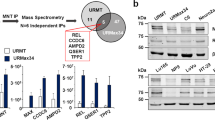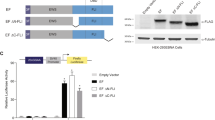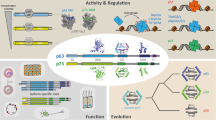Abstract
The oncogene v-rel of Reticuloendotheliosis virus, strain T, is derived from an avian c-rel proto-oncogene. c-rel encodes a member of the Rel/NF-κB family of transcription factors. The highly oncogenic v-Rel differs from c-Rel which has low transforming potential by the acquisition of numerous mutations. In this manuscript, we demonstrate that the oncogenic mutations in v-Rel directly alter the ability of this protein to bind to DNA. Electrophoretic mobility shift analysis with Rel proteins synthesized in vitro as well as isolated from nuclei of Rel expressing cells showed that three mutation clusters, present in the N-terminus, the center and the C-terminus of v-Rel, altered three different aspects of DNA binding. In contrast, the oncogenic C-terminal deletion of 118 amino acids present in v-Rel had almost no influence on its DNA binding. The N-terminal mutation cluster altered the κB DNA-binding specificity of the v-Rel oncoprotein relative to c-Rel. The mutation Met-20→Thr was found to be principally responsible for this alteration. The second mutation cluster was responsible for increased binding of v-Rel to all the κB sites examined presumably because it stabilized v-Rel homodimers. This alteration in DNA binding was mapped to the group of two mutations within the cluster. In contrast, the third mutation cluster in the C-terminus of v-Rel destabilized the binding of v-Rel to all of the κB sites examined. This is the first indication that regions outside the Rel Homology Region can participate in the control of binding of the c-Rel protein to DNA. The three mutation clusters examined contributed to the tumorigenic potential of v-Rel with the relative strength decreasing with their position from the N-terminus to the C-terminus. These results suggest that the oncogenic mutations in v-Rel cooperate and enable v-Rel to form nuclear complexes with aberrant DNA-binding properties that may directly alter gene expression and DNA replication resulting in the transformation of the cell.
This is a preview of subscription content, access via your institution
Access options
Subscribe to this journal
Receive 50 print issues and online access
$259.00 per year
only $5.18 per issue
Buy this article
- Purchase on Springer Link
- Instant access to full article PDF
Prices may be subject to local taxes which are calculated during checkout
Similar content being viewed by others
Author information
Authors and Affiliations
Rights and permissions
About this article
Cite this article
Nehyba, J., Hrdlicková, R. & Bose Jr, H. Differences in κB DNA-binding properties of v-Rel and c-Rel are the result of oncogenic mutations in three distinct functional regions of the Rel protein. Oncogene 14, 2881–2897 (1997). https://doi.org/10.1038/sj.onc.1201150
Received:
Revised:
Accepted:
Issue Date:
DOI: https://doi.org/10.1038/sj.onc.1201150
Keywords
This article is cited by
-
ERK and JNK activation is essential for oncogenic transformation by v-Rel
Oncogene (2010)
-
Cell transformation by v-Rel reveals distinct roles of AP-1 family members in Rel/NF-κB oncogenesis
Oncogene (2010)
-
The activation of TC10, a Rho small GTPase, contributes to v-Rel-mediated transformation
Oncogene (2007)
-
An optimal range of transcription potency is necessary for efficient cell transformation by c-Rel to ensure optimal nuclear localization and gene-specific activation
Oncogene (2007)
-
Divergent C-terminal transactivation domains of Rel/NF-κB proteins are critical determinants of their oncogenic potential in lymphocytes
Oncogene (2004)



